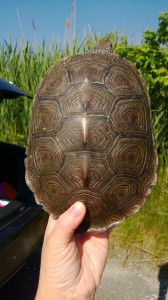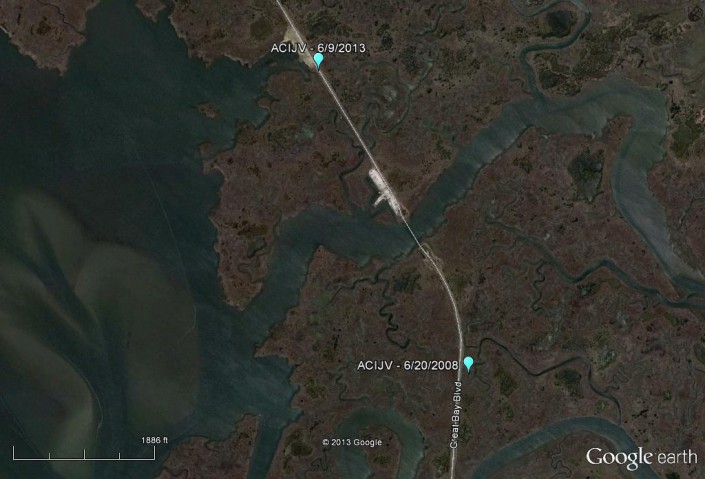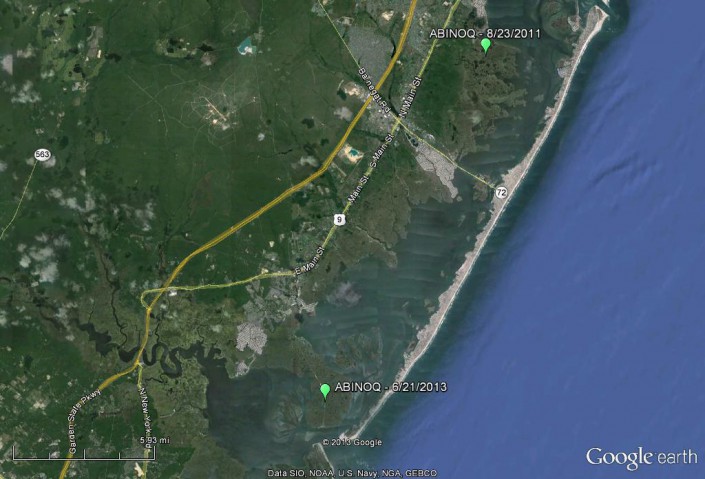Interesting recaptures on Great Bay Blvd.
Barnegat Bay terrapin moves south…
by Ben Wurst, Habitat Program Manager

Northern diamondback terrapins are known to have a very small home range. Some have only been found to occupy the same small creeks, year after year. To help study the size of terrapin populations in New Jersey researchers have used a method called mark and recapture. No one really knows the size of the terrapins population in New Jersey and throughout the range of the Northern subspecies, which ranges from Cape Cod to Cape Hatteras. A portion of the population is captured, marked, and released. The method is repeated and the number of marked individuals is counted and should reflect a proportional number of marked individuals in the entire population.
Since 2001 terrapins have been marked on Great and Barnegat Bays. This past summer we got hits on three females that were PIT tagged (it’s like the Home Again chip for your pet). Their tags were read during road patrols by our intern Ashley. Two of the three were linked back to previous captures. Each is ID’d by the notches on their carapace (upper shell). Each bridge scute on their carapace is assigned a alpha code.
- ACIJV – First encountered on June 20, 2008 at age 7. Weighed 805 grams with a carapace length of 157cm. She was recaptured again this summer by Ashley on June 9. She is now 12 years old and weighed 934grams. Her carapace was 170cm long. She moved only .86 miles or 4,561 feet from her last encounter, which is typically the small range seen in terrapins.
- The second is ABINOQ – she was orginally trapped on Barnegat Bay (near Gunning River and the Barnegat Docks) on August 23, 2011. She was 8 when trapped and weighed 766 grams with a CL of 170mm. She was re-caught this summer while crossing Great Bay Blvd in Little Egg Harbor. This now makes her 10 years old and she weighed 965 grams and had a CL of 180mm. Now she moved a total of 16.7 miles in two years!!


I find it really hard to believe that ABINOQ traveled 16 miles south in two years. There are a couple ways that she could have moved that far south. Superstorm Sandy – I think that this is a good possibility. Usually in late October most terrapins should have been entering hibernation, but a few could have still been active. I got a couple calls shortly after the storm hit from residents in the Little Egg Harbor area who found displaced terrapins in their yards. Given the fact that upwards of 6 feet of water were forced onto the coastal marshes with the storm surge, this could have pushed ABINOQ south towards Great Bay Blvd, where she was encountered this summer. Human intervention – this is also a very likely scenario. People often pick up terrapins when they find them on or near roads and sometimes take them home. Other times they take them and put them somewhere else, where they think they should belong… This summer I found a large female on an inland road in Upper Twp. (Cape May County). She was over 1.5 miles from any kind of brackish water…which is a long distance for any aquatic turtle to travel on land!
These findings are really interesting and with the data collected we’ll be able to learn a lot more about the local terrapin population. We hope to expand the use of PIT tags readers by fundraising to purchase additional readers. If you’d like to donate to help us purchase one, please shoot me an email.
Discover more from Conserve Wildlife Foundation of NJ
Subscribe to get the latest posts sent to your email.